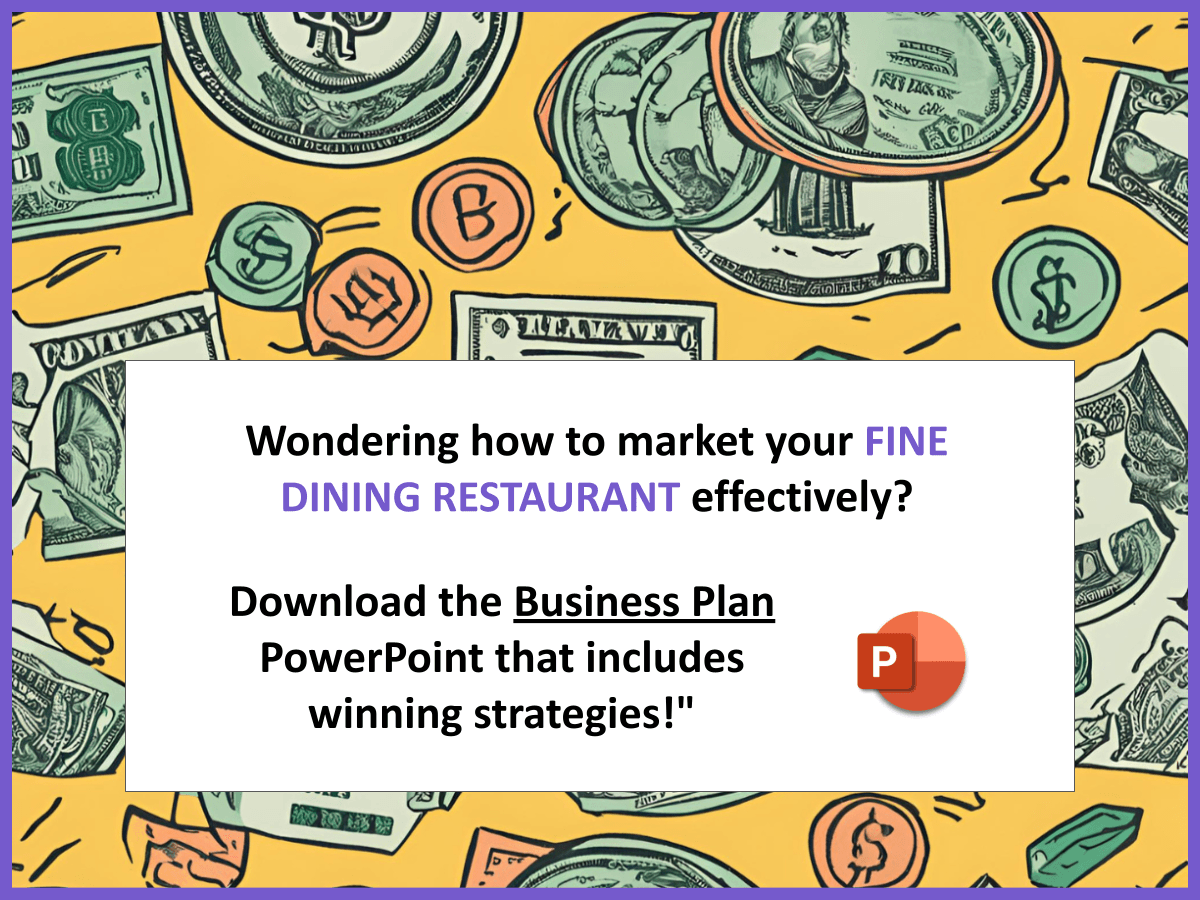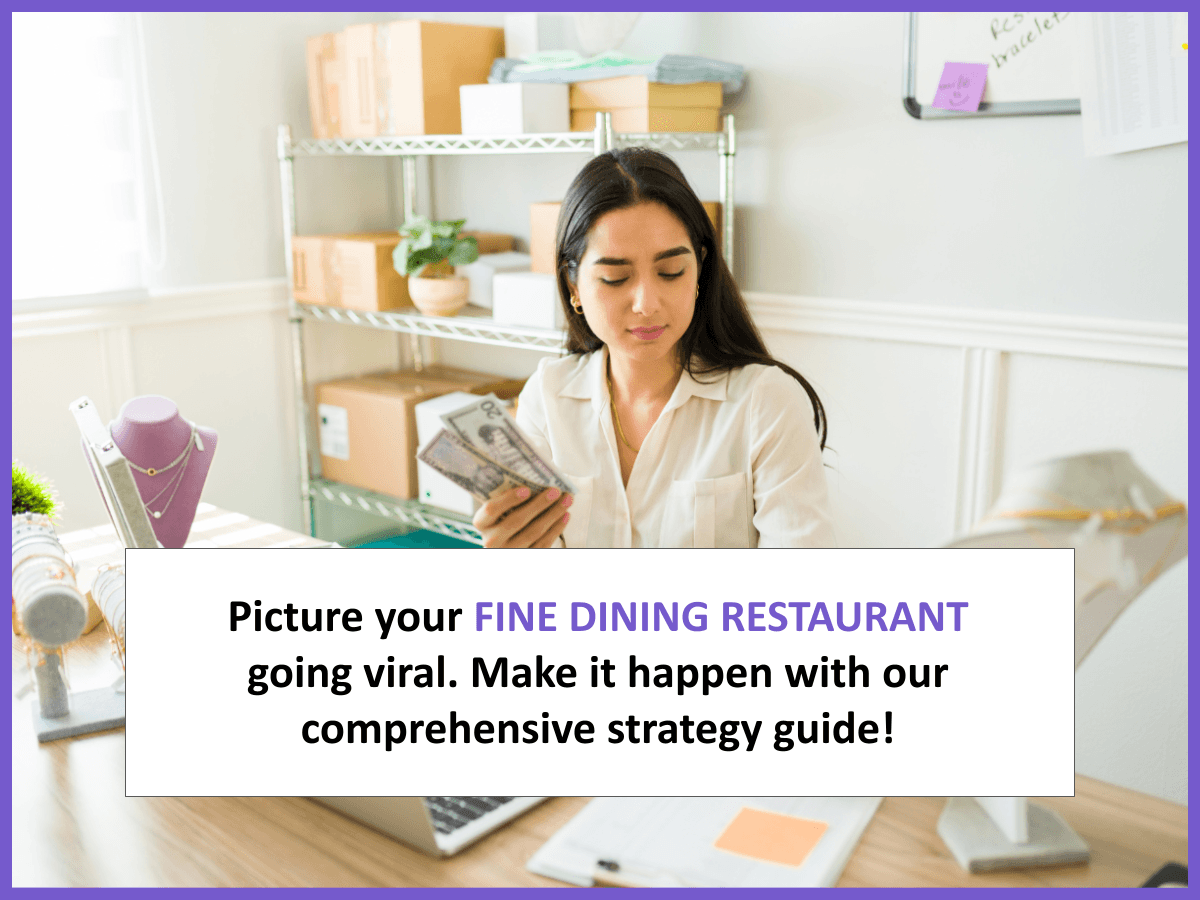Are you thinking about opening a fine dining restaurant? You’re not alone! With the restaurant industry projected to grow by a staggering 10% in the next few years, now is the perfect time to get your slice of the pie. But how do you make your restaurant shine in a competitive market? A well-crafted Fine Dining Restaurant Marketing Plan is your roadmap. Essentially, it’s a strategy that defines how you’ll attract customers, position your restaurant, and boost sales.
Understanding who your target market is can make all the difference. Think about who you want to attract—young professionals, families, or maybe foodies? Knowing their demographics helps tailor your marketing strategies. Let’s dive into defining your target market and understanding your ideal customers.
1. Define Your Target Market
| Demographics | Location | Dining Preferences |
|---|---|---|
| Age Range | Urban or Rural | Casual vs. Formal |
| Income Level | Neighborhood | Dietary Restrictions |
To start your Fine Dining Restaurant Marketing Plan, the first step is identifying the target market. This means mapping out who your ideal diners are. For instance, if you’re in a city area that caters to the upper class, your target market could range from affluent young professionals to upscale families. I remember a time when I had to rethink my approach after realizing my initial target audience was way too broad.
Another crucial aspect is location. Are you setting up shop in an urban area bustling with nightlife? Or maybe in a quieter suburban locale? This can drastically influence your marketing strategies for your restaurant. Lastly, consider their dining preferences. Are they adventurous eaters or do they prefer classic dishes? Once you have a clear picture, you can better focus your marketing efforts.
2. Understand Your Ideal Customers
| Characteristics | Behaviors | Expectations |
|---|---|---|
| Interests | Dining Frequency | Food Quality |
| Personality Traits | Spending Habits | Service Expectations |
Once you know who they are, it’s time to dive deeper. This is all about getting into the mindset of your ideal customers. What are their interests? Are they food enthusiasts, health-conscious eaters, or perhaps wine connoisseurs? Understanding these traits helps in curating your dining experience.
Now, think about their behaviors. How often do they dine out? When do they usually eat? I once learned through trial and error that targeting diners who go out more frequently led to repeat customers, especially during special promotions. Pay attention to their spending habits, as knowing if they prefer fine wines or cheerful cocktails can directly impact your offerings.
Lastly, consider their expectations. Diners today have high standards and expect top-notch food quality and impeccable service. It’s been clear from my experience that you must meet or exceed these expectations to build a loyal customer base.
3. Analyze Your Competitors
| Competitor Name | Strengths | Weaknesses |
|---|---|---|
| Competitor A | Reviews, Location | Limited Menu |
| Competitor B | Ambiance, Prices | High Staff Turnover |
Knowing what your competitors offer can help you identify gaps in the market. Analyzing their strengths and weaknesses is key to crafting your own Fine Dining Restaurant Marketing Plan. Personally, I had a friend who opened a restaurant across the street from a well-known one, and it was strategic work like this that set her apart.
Start by listing your local competitors. What do they do well? Do they have rave reviews, or are their prices lower than yours? Don’t just focus on the positives; understanding their weaknesses is equally important. Maybe they have a limited menu that doesn’t cater to certain dietary preferences. This is where you can capitalize by offering a more diverse menu.
Lastly, keep an eye on their marketing strategies. Do they have a strong social media presence? Are they partnering with influencers? Learning from others’ successes (and failures) can lead you on the path to your restaurant’s marketing triumphs.
4. Establish Clear Marketing Objectives for Your Fine Dining Restaurant Marketing Plan
| Objective | Measurement | Timeline |
|---|---|---|
| Increase Reservations | By 20% | 3 Months |
| Improve Social Media Engagement | By 50% | 6 Months |
Setting specific and measurable objectives is crucial for your Fine Dining Restaurant Marketing Plan. For instance, decide how many reservations you’d like to increase by over the next few months. Personally, I find that having clear goals not only keeps the team focused but also helps in tracking progress effectively.
Think about your marketing objectives. Do you want to boost your online presence, increase foot traffic, or perhaps improve customer satisfaction ratings? Make sure each objective aligns with what you want to achieve in your first year. For example, aiming to improve social media engagement by 50% within 6 months gives you an actionable target.
Remember, these objectives should not just be numbers on a page. Revisit them frequently to see if you’re on track. If you’re falling short, it’s an indicator to re-evaluate your marketing strategies and adjust accordingly. I’ve seen too many restaurants overlook this part, thinking setting goals is enough without the follow-through!
5. Choose Effective Marketing Strategies for Your Fine Dining Restaurant Marketing Plan
| Strategy | Target Audience | Expected Outcome |
|---|---|---|
| Social Media Ads | Food Lovers | Higher Brand Awareness |
| Influencer Partnerships | Millennials | Increased Foot Traffic |
Picking the right strategies can really make or break your Fine Dining Restaurant Marketing Plan. It’s not about just throwing spaghetti at the wall to see what sticks; you need to have a clear focus. For example, consider using social media ads. With more people scrolling through their feeds, targeted ads can bring your restaurant to the forefront of potential customers’ minds.
Another effective approach is forging partnerships with food influencers. Nowadays, a shoutout from a local food blogger can bring in droves of new diners eager to try your dishes. I once saw a pop-up restaurant gain instant popularity just from the power of a few social media posts. So, consider utilizing platforms like Instagram or TikTok to showcase your culinary creations!
Don’t forget traditional marketing methods too. Flyers in nearby businesses, local food events, and community engagement help establish your brand within the community. This blend of digital and conventional marketing strategies can be powerful. Just remember to measure the effectiveness of each strategy regularly so you can pivot when necessary!
6. Evaluate and Adjust Your Approach
| Evaluation Method | Frequency | Adjustment Steps |
|---|---|---|
| Surveys | Quarterly | Implement Feedback |
| Sales Data Review | Monthly | Change Menu if Needed |
Evaluating your efforts ensures that your Fine Dining Restaurant Marketing Plan remains relevant and effective. Set a schedule to review your marketing tactics regularly. I’ve found that surveys can be incredibly useful. Asking customers for their opinions at the end of the meal can provide invaluable insights.
Also, keep an eye on your sales data. Check which items sell like hotcakes and which ones are barely making the cut. Adjusting your menu based on what customers love helps keep things fresh and relevant. This is something I overlooked early in my restaurant journey; I kept items on the menu that nobody ordered simply because I liked them!
Ultimately, be prepared to pivot when needed. Maybe a certain marketing strategy isn’t yielding results; perhaps a new diner trend emerges that you want to tap into. Being flexible and responsive can make all the difference between thriving in your local market and simply getting by.
7. Example N°1 of Marketing Plan for Fine Dining Restaurant
| Steps | Actions | Details |
|---|---|---|
| 1 | Target Market | Identify age, income, and interests of local food lovers. |
| 2 | Ideal Customers | Focus on couples looking for romantic dining experiences. |
| 3 | Competitors | Analyze local upscale dining options. |
| 4 | Marketing Objectives | Increase bookings by 30% within three months. |
| 5 | Marketing Strategies | Engage customers with special promotion nights. |
| 6 | Evaluation | Monthly assessment of customer feedback and booking rates. |
This first example showcases a marketing plan focused on attracting couples for romantic dinners. By targeting a specific demographic and creating an ambiance conducive to romance, this plan can set the restaurant apart. I once implemented a similar concept, which involved hosting date night events that really boosted our evening reservations.
8. Example N°2 of Marketing Plan for Fine Dining Restaurant
| Steps | Actions | Details |
|---|---|---|
| 1 | Target Market | Focus on corporate clients and business gatherings. |
| 2 | Ideal Customers | Companies looking for upscale private dining experiences. |
| 3 | Competitors | Study high-end venues that cater to corporate needs. |
| 4 | Marketing Objectives | Book 5 corporate events per month within 6 months. |
| 5 | Marketing Strategies | Leverage LinkedIn and create targeted corporate packages. |
| 6 | Evaluation | Quarterly analysis of corporate bookings and client feedback. |
This second example zeroes in on attracting corporate clientele. By tailoring the offerings and utilizing platforms like LinkedIn, this plan builds a niche presence. I’ve learned from past experiences that accommodating business needs can lead to lucrative partnerships, especially in fine dining. Having good packages ready for corporate clients can make a significant impact!
9. Example N°3 of Marketing Plan for Fine Dining Restaurant
| Steps | Actions | Details |
|---|---|---|
| 1 | Target Market | Identify food lovers seeking unique culinary experiences. |
| 2 | Ideal Customers | Adventurous eaters interested in seasonal and exotic dishes. |
| 3 | Competitors | Evaluate other fine dining spots offering unique menus. |
| 4 | Marketing Objectives | Increase social media following by 40% in the next 6 months. |
| 5 | Marketing Strategies | Host a monthly tasting event featuring seasonal dishes. |
| 6 | Evaluation | Review event turnout and social media analytics quarterly. |
This third example highlights a marketing plan centered around creating unique culinary experiences. By attracting adventurous diners who crave seasonal and exotic offerings, the restaurant can stand out effortlessly. Hosting monthly tasting events builds community engagement and garners excitement on social media. I’ve seen first-hand how these events not only elevate your offerings but also create buzz and community around your brand!
10. Example N°4 of Marketing Plan for Fine Dining Restaurant
| Steps | Actions | Details |
|---|---|---|
| 1 | Target Market | Identify local residents interested in gourmet dining. |
| 2 | Ideal Customers | People celebrating special occasions like anniversaries. |
| 3 | Competitors | Assess fellow gourmet establishments in your area. |
| 4 | Marketing Objectives | Boost reservation numbers for special occasions by 25%. |
| 5 | Marketing Strategies | Create celebration packages for anniversaries and birthdays. |
| 6 | Evaluation | Analyze reservations and customer reviews after celebrations. |
This fourth example focuses on special events, aiming to attract customers who want to celebrate significant occasions. By crafting tailored celebration packages, the restaurant can encourage reservations for anniversaries and other milestones. I’ve found these types of promotions resonate deeply with customers; they appreciate the extra thought put into making their experience memorable. That’s how you build loyalty and make people come back for more!
11. Example N°5 of Marketing Plan for Fine Dining Restaurant
| Steps | Actions | Details |
|---|---|---|
| 1 | Target Market | Focus on health-conscious diners seeking gourmet meals. |
| 2 | Ideal Customers | Individuals interested in organic and locally-sourced ingredients. |
| 3 | Competitors | Evaluate other health-focused dining establishments. |
| 4 | Marketing Objectives | Educate customers about the health benefits of menu items. |
| 5 | Marketing Strategies | Host workshops on healthy eating and cooking classes. |
| 6 | Evaluation | Gather participant feedback from workshops and events. |
This fifth example highlights a plan that centers on health-conscious eaters interested in gourmet meals. By sourcing organic and local ingredients, the restaurant can create a unique spot that stands out in a crowded market. Hosting workshops on healthy eating is a fantastic way to educate your customers while building community ties. In my experience, when diners feel knowledgeable about your offerings, they’re more likely to become loyal patrons!
12. Example N°6 of Marketing Plan for Fine Dining Restaurant
| Steps | Actions | Details |
|---|---|---|
| 1 | Target Market | Identify millennials seeking unique dining experiences. |
| 2 | Ideal Customers | Adventurous diners who love sharing food on social media. |
| 3 | Competitors | Analyze social media presence of local fine dining spots. |
| 4 | Marketing Objectives | Increase user-generated content by 30% through social campaigns. |
| 5 | Marketing Strategies | Encourage diners to share their restaurant experiences online. |
| 6 | Evaluation | Monitor social media engagement and campaign results. |
This example targets millennials by focusing on unique dining experiences that they can showcase on social media. By encouraging user-generated content, the restaurant can build a loyal following and enhance its online presence. I’ve seen how impactful social shares can be; it’s like free advertising that gets people genuinely interested in your restaurant!
13. Example N°7 of Marketing Plan for Fine Dining Restaurant
| Steps | Actions | Details |
|---|---|---|
| 1 | Target Market | Identify foodies looking for innovative dining options. |
| 2 | Ideal Customers | Individuals who are always on the lookout for new flavors. |
| 3 | Competitors | Assess local restaurants known for culinary creativity. |
| 4 | Marketing Objectives | Launch a seasonal menu that attracts 50 new customers weekly. |
| 5 | Marketing Strategies | Collaborate with local chefs for exclusive tasting events. |
| 6 | Evaluation | Analyze sales from seasonal offerings and tasting event attendance. |
This final example focuses on attracting foodies who are keen on innovative dining options. By launching a seasonal menu and partnering with local chefs, the restaurant can draw in curious diners eager for new flavors. This approach not only helps in generating excitement but also keeps the menu fresh and enticing. I remember collaborating with a guest chef once and the buzz around it was phenomenal! It really drove home the importance of creativity in marketing your fine dining experience.
Conclusion
Creating a robust Fine Dining Restaurant Marketing Plan is essential for standing out in a crowded market. By understanding your customers, analyzing competitors, and implementing strategic marketing objectives, you’re setting the stage for success. Remember, marketing doesn’t end with a plan; it should be an ongoing process of evaluation and adjustment. If you’re looking for additional guidance, consider exploring a comprehensive template for your fine dining establishment here.
If you’re just starting out in the industry, check out our articles on how to kickstart your journey with How To Start a Fine Dining Restaurant Business? and learn how to assess your strengths, weaknesses, opportunities, and threats with our guide on Fine Dining Restaurant SWOT Analysis. Empower yourself with the right knowledge, and watch your restaurant thrive!
FAQ
- What is a fine dining restaurant marketing plan?
A fine dining restaurant marketing plan is a strategic document that outlines how a restaurant will attract and retain customers while positioning itself in the market. - How can I promote my fine dining restaurant?
You can promote your fine dining restaurant through social media, local advertisements, engaging in community events, and hosting exclusive tasting events. - Who is the target advertise for fine eating restaurants?
The target market usually includes affluent individuals, couples looking for dining experiences, and food enthusiasts seeking high-quality gourmet meals. - What marketing strategies work best for fine dining?
Effective strategies include social media advertising, influencer partnerships, and hosting unique events to attract foodies and create brand buzz. - How do I analyze competitors in the fine dining sector?
Study their menus, pricing, customer reviews, and marketing strategies to find gaps you can exploit to differentiate your restaurant. - Why is customer feedback important?
Customer feedback helps improve service quality and menu offerings, which is crucial for maintaining a competitive edge in the fine dining market. - What are common marketing objectives for fine dining restaurants?
Common objectives include increasing reservations, improving customer retention, enhancing brand awareness, and boosting social media engagement. - How often should I evaluate my marketing plan?
It’s recommended to evaluate your marketing plan at least quarterly to assess performance and make necessary adjustments. - What role does social media play in fine dining marketing?
Social media plays a significant role in building brand awareness, engaging with customers, and sharing visually appealing content that attracts diners. - How can I create a unique dining experience?
Consider using seasonal ingredients, unique menu items, and personalized service to make your restaurant stand out and create memorable experiences for diners.







